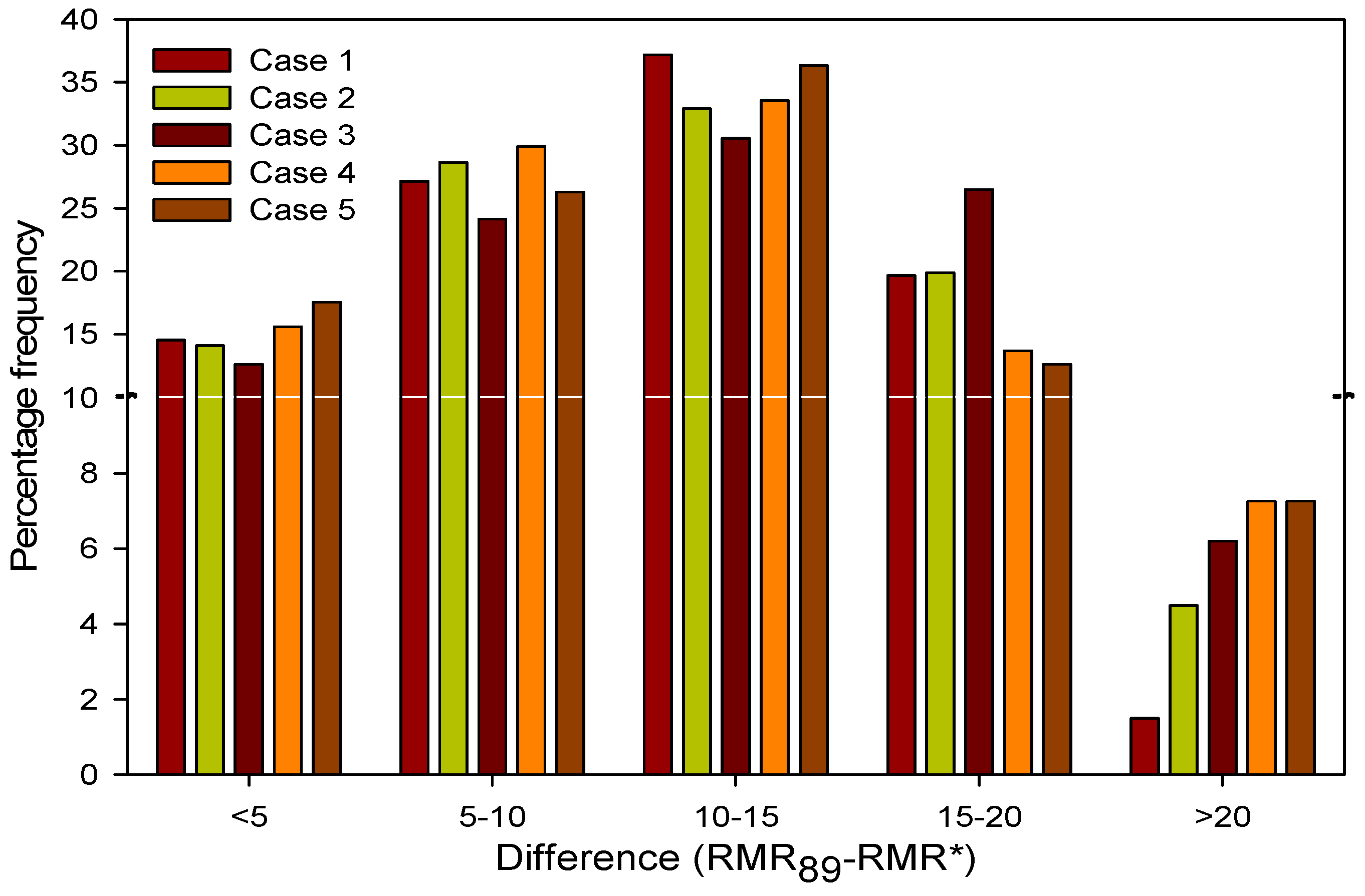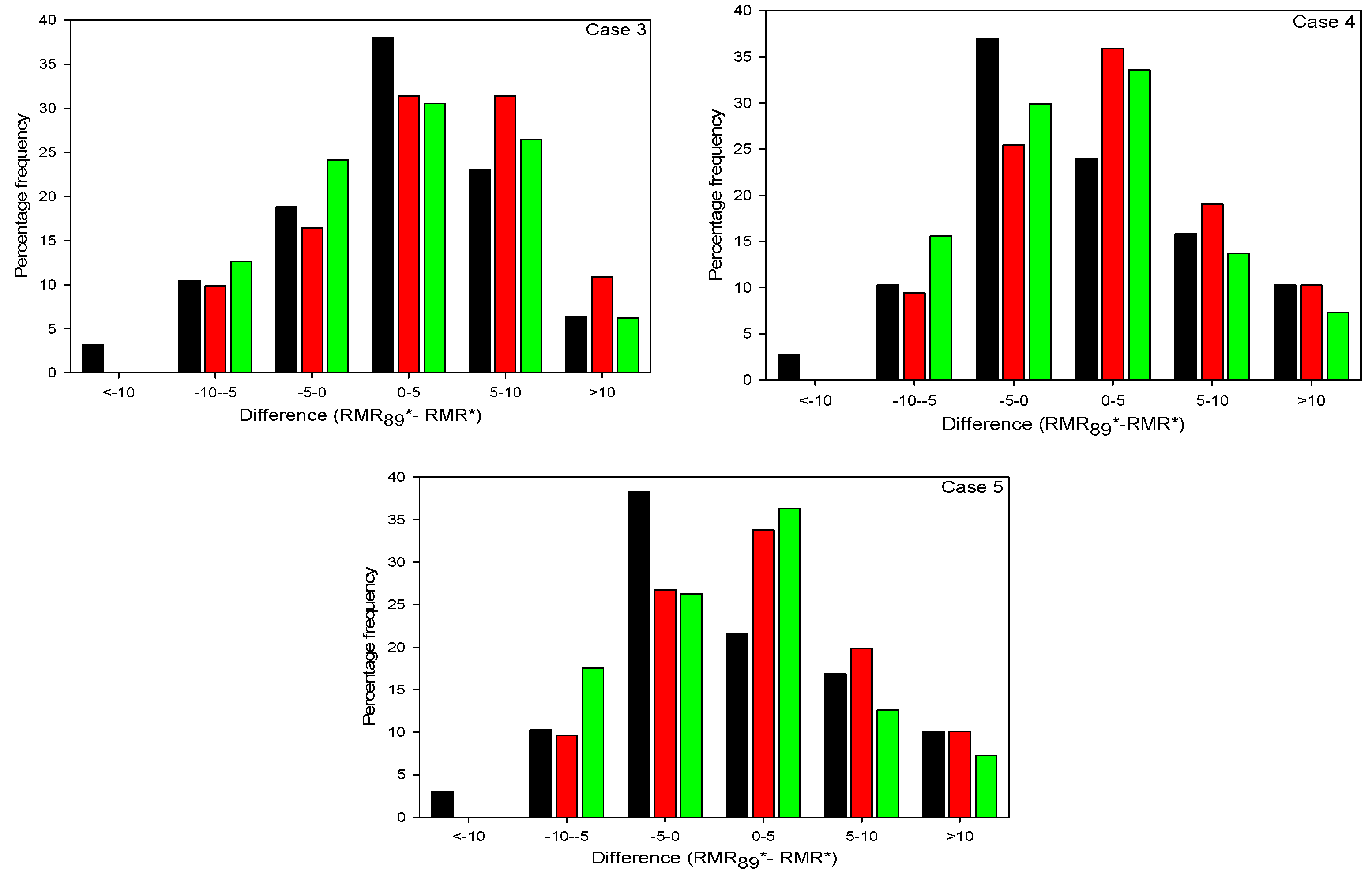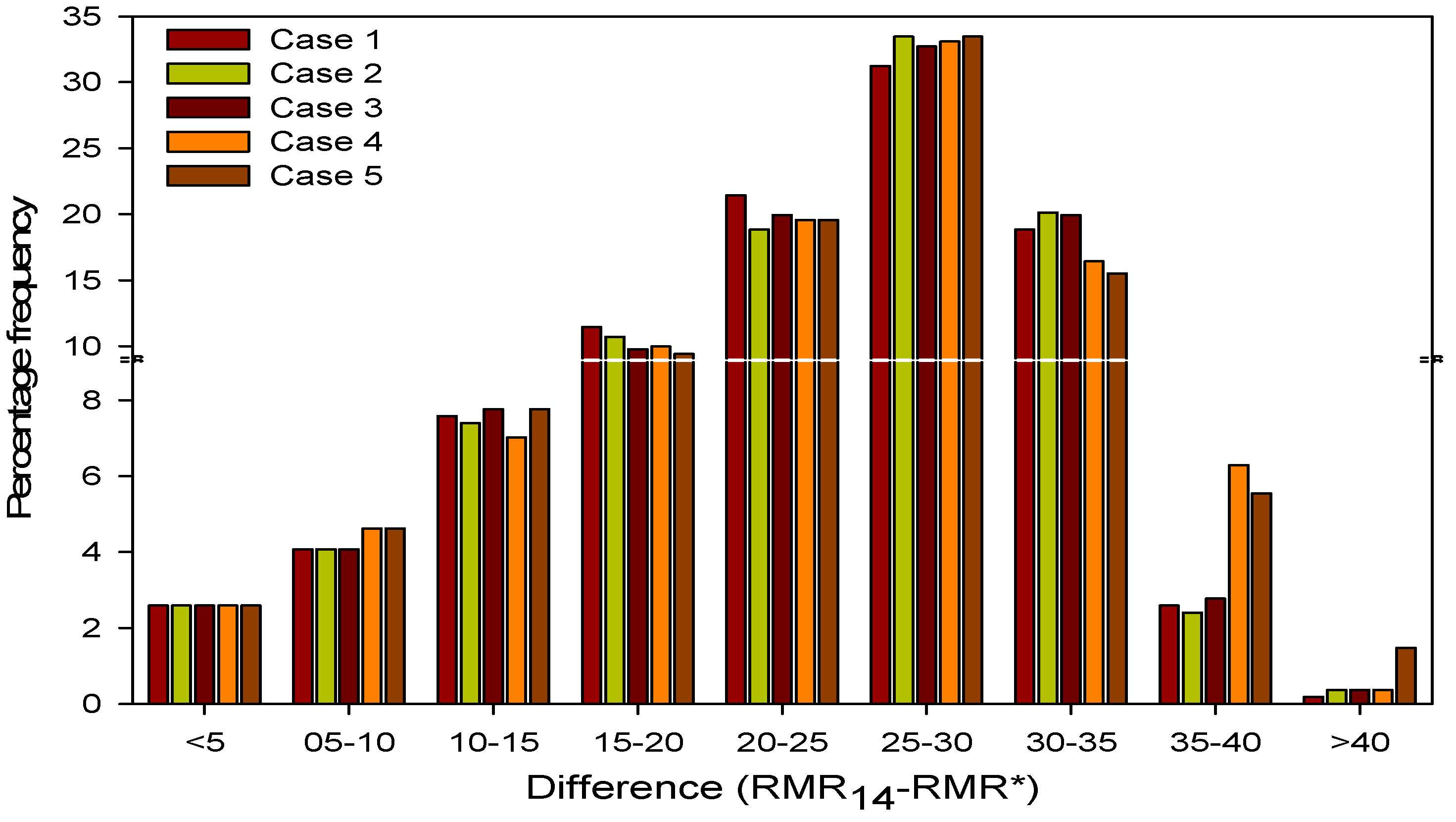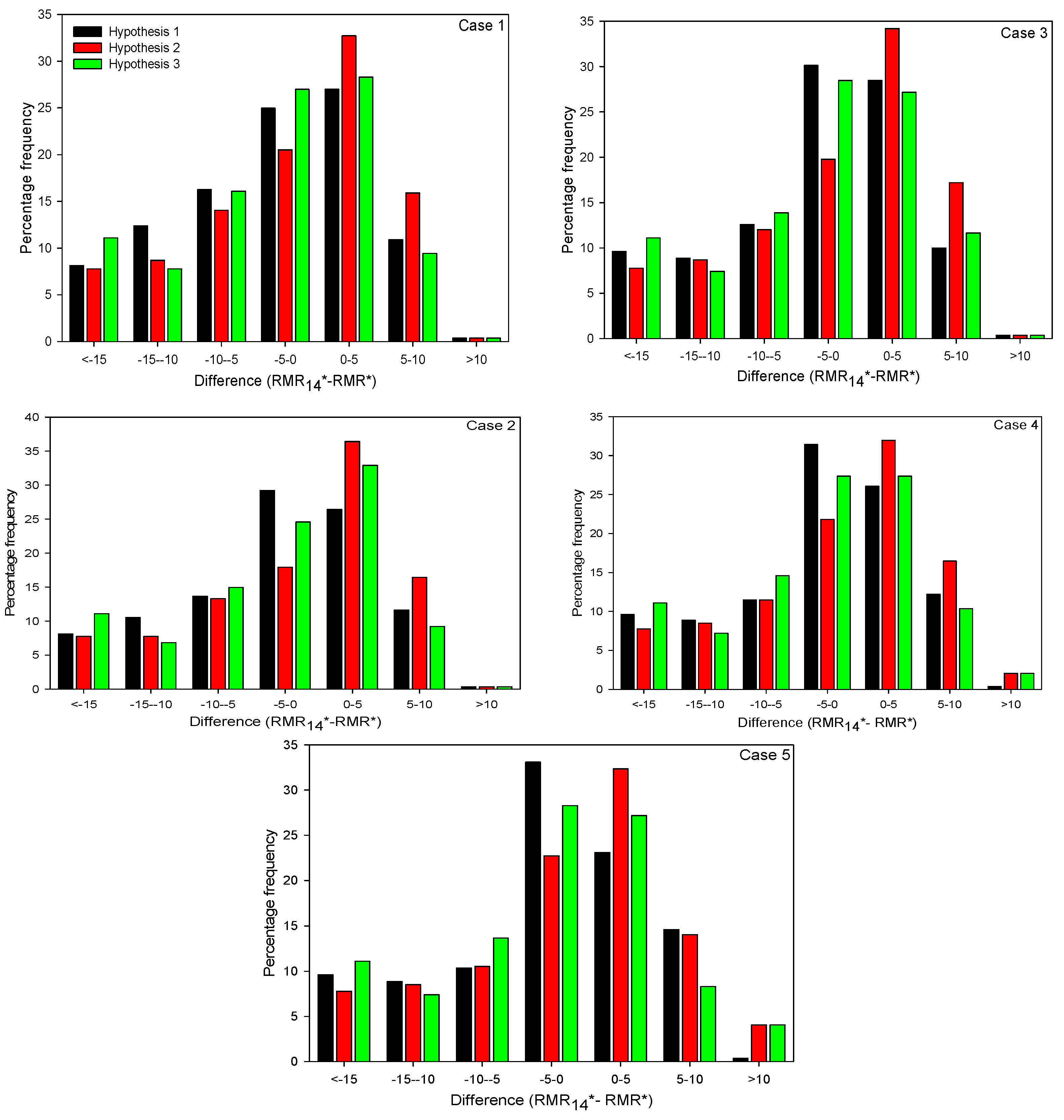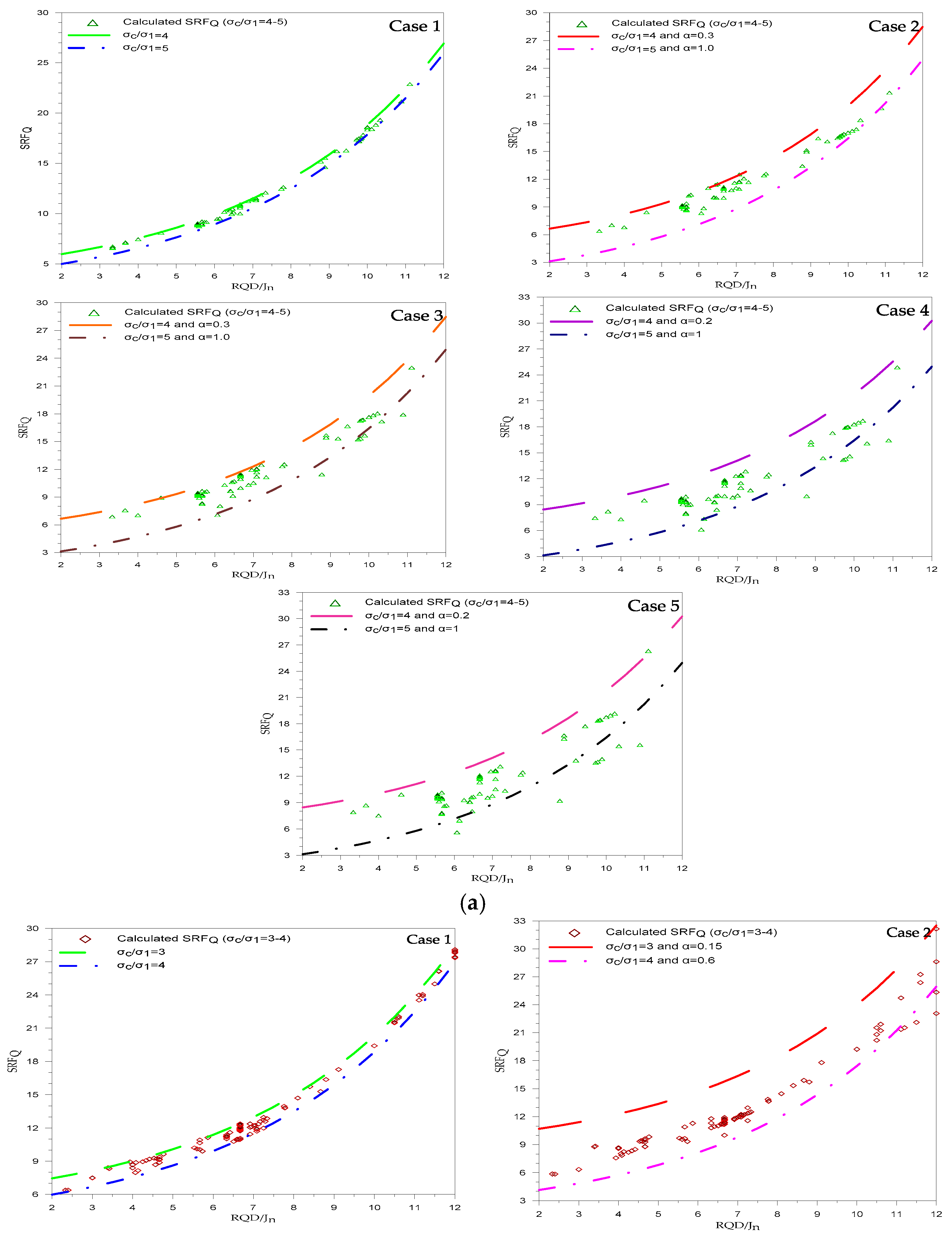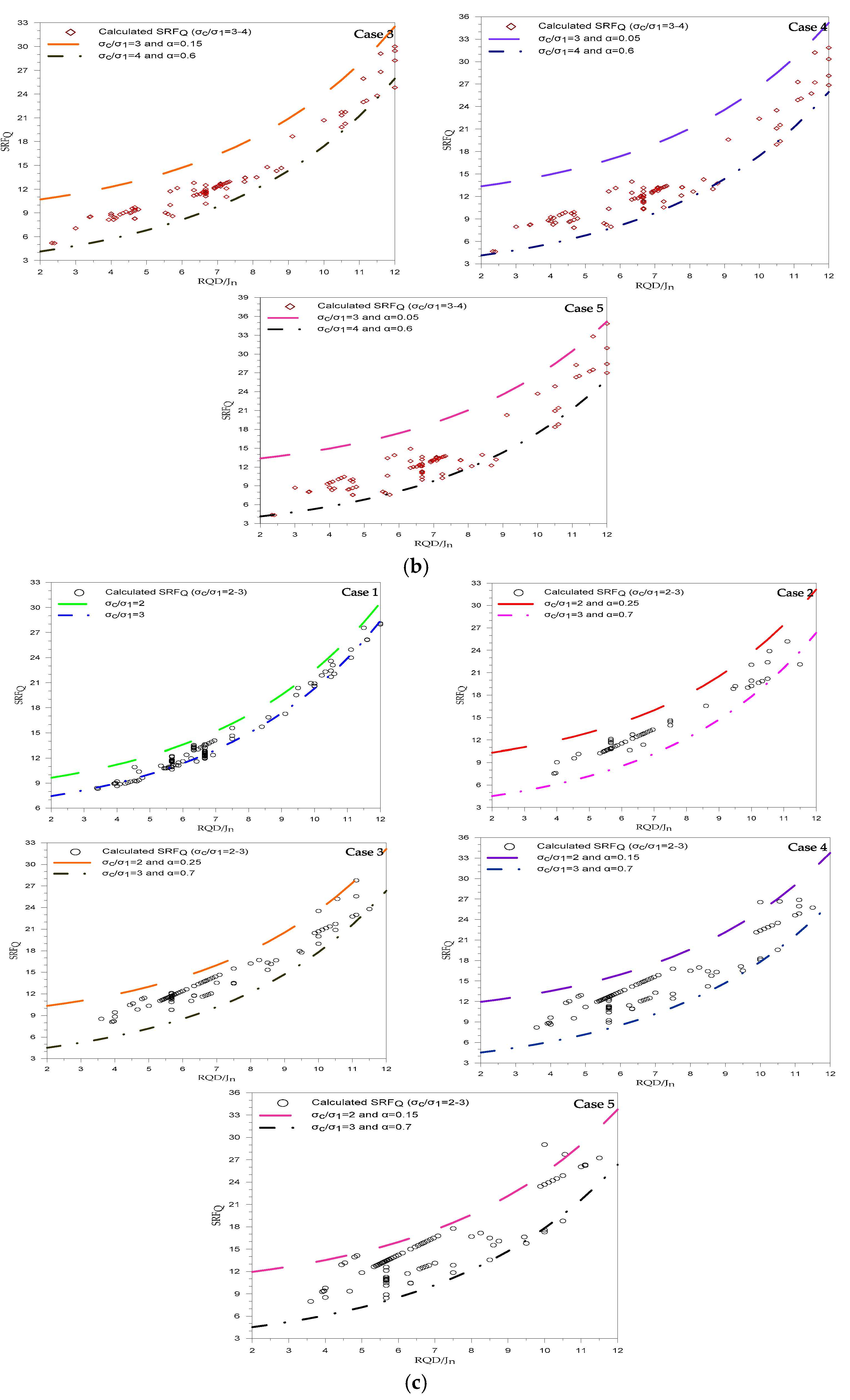1. Introduction
The depth of underground excavations is increasing day by day for different civil and mining engineering projects posing more challenges for safe and economic construction [
1,
2,
3]. The difficulties for modelling such underground excavations due to the complex nature of rock mass are decreasing due to advancement in the research and technology, materials and systems not only in the conventional excavations methods, but also in mechanized one [
4,
5,
6,
7]. In underground excavations, the issues related to the rock-mass behavior comprise the strength properties of intact rock, joint related aspects, environmental features (ground water and in situ stresses), configuration of the excavation cross section, and the excavation method; furthermore, these issues define the support required for the underground excavation [
8,
9]. The ability to forecast the rock-mass quality and support pattern during the design of underground excavation is a challenging and risky task [
10]. To stabilize these excavations, researchers characterize the ground in such a manner that is suitable for the support design based on past experiences, which has resulted in the development of different empirical rock-mass classification systems. Till date, empirical rock-mass classification systems have been proposed for the tunnel support system design since the earliest empirical classification proposed by Terzaghi in 1946 known as the rock load classification [
4]. Some of the recommended classification systems are not favored by engineers owing to their non-practical application, but few have been frequently used owing to their reliability and practicality. The most extensively used empirical classifications of rock mass during tunnel design and construction in the world are the rock-mass rating (
RMR) classifications and tunneling quality index (
Q) systems [
11,
12]. These two systems for the classification of rock masses used by engineers provide convenience in defining the preliminary support systems. The applicability of these systems has been extended with improvements in tunnel construction technology and these systems are revised extensively either in the form of characterization or support [
4].
Based on ground behaviors and the available tools for underground excavation in rock engineering, the application of empirical classification systems are limited to different ground behavior during tunnel excavation and stabilization [
8]. In empirical classification systems, fiber-reinforced shotcrete and rock bolts are preliminary supports that are recommended during tunnel design and construction, and
RMR and
Q systems are effective tools for this purpose. The updated versions of these two systems suggest the shotcrete thickness and rock bolt spacing based on the same principles [
13], as the excavation support ratio (ESR) in the
Q system is not a parameter that is generally used worldwide, and individual countries have their own respective standards [
14]. According to these principles, the fiber-reinforced shotcrete thickness is a function of the rock-mass quality (
RMR and
Q) and tunnel span; however, the rock bolt spacing is only a function of the rock-mass quality. During tunnel stability, fiber-reinforced shotcrete and installed rock bolts act as a compound support system and the contribution of individual support depends upon its installation time and distance from the excavation face [
15]. Based on the relationships of the rock-mass quality with the spacing of rock bolts (20 mm dimeter) and thickness of fiber-reinforced shotcrete in the support charts of each system, a back analysis approach was established for the determination of the rock-mass quality from the tunnel span, shotcrete thickness, and rock bolt spacing in already supported tunnels [
16]. These two relations were used for the back-calculation of the rock-mass quality, and their averaged value (rock-mass quality obtained from shotcrete thickness and tunnel span, and the rock-mass quality obtained from rock bolts spacing) was used for the final calculation of the
RMR* (
RMR calculated through back-calculation) and
Q* (
Q value calculated through back-calculation). This averaged value approach is adopted owing to the unavailability of assessment criterion for calculating the rock-mass quality value according to the importance of the support (rock bolt and shotcrete) with the span in the two classification systems.
To extend the application of empirical classification systems (especially
RMR and
Q) to different ground behaviors for the tunnel excavation and stability, weightage effect during back-calculation of rock-mass quality is critical. Owing to the unavailability criterion for the final calculations of the rock-mass quality (
RMR* and
Q*), five different cases are taken into consideration in this study to evaluate the weightage effect during the back-calculation of the
RMR* and
Q*. The weightage adopted in Cases 1 and 3 are already considered for the back-calculation of the rock-mass quality in the
Q system for their extension to a highly stressed jointed rock mass [
16,
17]. However, in the case of
RMR89 [
18] and
RMR14 [
19], which are the two versions of the
RMR systems, only the Case 3 weightage was assumed in the rock-mass quality back-calculation for the purpose of their extension. The different assessment cases adopted in this study are plotted, and the effect of the weightage in each case is discussed.
3. Results
The rock-mass quality was calculated using Equation (1) for the 542 tunnel sections of the four tunnel projects following the two approaches of calculating rock-mass quality through characterization (
RMR89) and back-calculation (
RMR*). All the five cases of
Table 6 were considered in the
RMR* calculation. Of the 542 tunnel sections, 468 sections show that
RMR89 >
RMR* for all the five cases of weightage. The cases that show the difference (
RMR89-
RMR*) as a positive value are plotted in
Figure 2.
To evaluate the effect of the weightage for all the five cases in the stress adjustment factor for
RMR89, three hypotheses were adopted for the
Fstress−89. These hypothesis were also used for the extension of the
RMR89 application for the rock-mass quality determination in highly stressed jointed rock-mass environments [
16]. The details of the hypothesis tested for the rating selection based on intact rock strength to major principal stress (
σ1) ratio (
σc/
σ1) are shown in
Table 3.
Using Equation (14), after applying the stress adjustment factor
Fstress−89, based on the selection criterion expressed in
Table 3 for all the 468 tunnel sections,
RMR89 was adjusted for the stress parameter (
RMR89*). The
RMR* was calculated using five different weightages of
Table 6. For each case, the
RMR89* and
RMR* are compared in terms of their difference (
RMR89*-
RMR*) for all the five cases of weightage and for three hypotheses and the obtained results are expressed in
Figure 3.
In case of
RMR14, the rock-mass quality was calculated using Equation (5) for the 542 tunnel sections of the four tunnel projects through characterization and was compared with the back-calculated
RMR while considering all the five cases of
Table 6. The comparison between the calculated
RMR (
RMR14) and back-calculated
RMR (
RMR*) for all the sections reveal that
RMR14 >
RMR* for all the five cases, and the details in terms of their difference (
RMR14-
RMR*) are shown in
Figure 4.
To evaluate the effect of the weightage for all the five cases in the stress adjustment factor for
RMR14, the three hypotheses were considered for the stress adjustment factor (
Fstress−14). The details of the hypothesis tested for the rating selection based on (
σc/
σ1) for
RMR14 are summarized in
Table 8.
Using Equation (16), after applying the stress adjustment factor based on the selection criterion expressed in
Table 7 for all the tunnel sections,
RMR14 was adjusted for a stress parameter as
RMR14* using Equation (16). The stress-adjusted
RMR14 (
RMR14*) and
RMR* are compared in terms of their difference (
RMR14*-
RMR*) for all the five cases of weightage and for the three hypotheses, and the obtained results are expressed in
Figure 5.
The data of the 542 tunnel sections (as summarized in
Table 5) were used in Equation (17). For Equation (17), the back-calculation rock-mass quality (
Q*) was determined using the five different weightages of
Q1* and
Q2* as per the details in
Table 6. On separating the number of cases based on
σc/
σ1 from the 542 sections, 156 tunnel sections were found to have this ratio in the range of 4 to 5. In the range of 3 to 4, 232 cases exist, and the remaining 154 sections have a strength–stress ratio in the range of 2 to 3. Cases 1 and 3 of
Table 6 are already respectively used for the extension of the application of the
Q system of Barton and the rock-mass index (
RMi) system of Palmstorm for a highly stress-jointed rock-mass environment [
16,
17]. The back-calculated rock-mass quality in
Figure 1 for all the five cases of weightage was taken as the
Q value in Equation (17) for the calculation of the
SRF (
SRFQ). This
SRFQ was plotted against the relative block size (
RQD/
Jn) for different ranges of strength–stress ratio for all the five cases of
Q* based on their weightage (
Table 6). The results are shown in
Figure 6. The best fit equation for Case 1 is Equation (19), and for the remaining four cases is Equation (20). Equations (19) and (20) are already suggested for Case 1 and 3, respectively [
16,
17]. For Case 2, the best fit Equation (20) has the same values for the constant α. However, in Cases 4 and 5, the constant α values are different, as shown in
Figure 6.
4. Discussion
The already supported tunnel sections data is used in this article. The same data is used for the extension of the RMR [
18,
19], tunneling quality index [
12,
26], and RMR index [
29] in highly stressed jointed rock-mass environments [
16,
17]. For the extension process, the back-calculation approach is used for the calculation of the rock-mass quality. In the back-calculation approach, the rock bolt spacing and shotcrete thickness are used along with the tunnel span for determining the rock-mass quality. As can be observed from
Figure 1, the final rock-mass quality depends on the rock-mass quality obtained from the rock bolt spacing and shotcrete thickness in combination with the tunnel size. Although the average weightage is used for the calculation of the final rock-mass quality, owing to the unavailability of any criterion, the different weightage effect was not studied. Therefore, five different weightages were selected for the final rock-mass quality determination as shown in
Table 6, and the obtained results are presented. For illustration, an example is used, the results of which are summarized in
Table 7.
Approximately 86% of the data shows that the back-calculated
RMR (
RMR*) is lower than the calculate
RMR (
RMR89) obtained using Equation (1), which indicates that the
RMR89 suggested supports are lighter than the actual support. This difference is shown in
Figure 2 in terms of the difference between
RMR89 and
RMR* and reveals that for all cases of weightage, this difference is highest in the rage of 10 to 15 points of
RMR. In each range of difference (<5, 5–10, 10–15, 15–20, and >20) the average vales for the five cases are 14.87, 27.22, 34.10, 18.46, and 5.34 with a standard deviation of 1.83, 2.21, 2.68, 5.59, and 2.43, respectively. This shows that for all the five ranges of differences, the deviation from the average of the five cases is very low except in the case of the range of 15–20, wherein the deviation is 5.59. This high deviation is due to the higher frequency of Case 3 with respect to other cases in the range 15–20. The percentage frequency of the difference between
RMR89 and
RMR* (
RMR89-
RMR*) in the range of 5 to 20 decreases with the case number, and these values are 84, 82, 81, 77, and 75 for Case 1—5, respectively. As the weightage of the rock-bolts-based back-calculated
RMR (
RMR1*) decreased along with the increase in the shotcrete-based
RMR (
RMR2*), the percentage frequency decreased. This decrease is due to the higher value of
RMR1* than
RMR2* in the maximum tunnel sections. After the application of the stress adjustment factor based on the strength–stress ratio as per the guidelines of
Table 3, the percentage frequency of the difference between the stress-adjusted
RMR (
RMR89*) and
RMR* is the greatest in the range of −5 to 5 for all the five cases of the weightage except Case 3 and Hypothesis 2, as shown in
Figure 3. For this case, the percentage frequency is 48 for (
RMR89*-
RMR*) in the range of −5 to 5. Hypothesis 1 of
Table 3 was selected as the stress adjustment factor based on strength–stress ratio obtained for
RMR89 [
16]. The leading case in terms of percentage frequency, where (
RMR89*-
RMR*) is in the range of −5 to 5 for Hypothesis 1, is Case 1 followed by Cases 2–5. Their values are 63, 62, 61, 60, and 57, respectively.
RMR14 is the latest version of the
RMR system, and therefore, the result of this version and
RMR* are compared for each section and expressed in
Figure 4 in terms of their difference. In each range of difference, in
Figure 4, the percentage frequency of each case is very close with a very low value of standard deviation. The maximum standard deviation is obtained for the difference range 30–35 with a value of 2.09 from the average value of 18.19. As the
RMR14 values are higher than
RMR89, as shown in
Table 2 and Equation (15), the difference (
RMR14-
RMR*) is greater than that between
RMR89 and
RMR* (
RMR89-
RMR*), as shown in
Figure 4.
Figure 4 reveals that for all the cases of weightage, this difference (
RMR14-
RMR*) is greatest in the range of 20 to 35 points of
RMR. In terms of the percentage frequency, their values are 72, 72, 73, 69, and 69 for Cases 1–5, respectively. Based on the correlation Equation (15),
RMR14 decreases significantly with the stress adjustment factor for all the hypotheses of
Table 8. After the application of the stress adjustment factor based on the strength–stress ratio as per the guidelines of
Table 8, the percentage frequency of the difference between the stress-adjusted
RMR14 (
RMR14*) and
RMR* is greatest in the range of −5 to 5 following all the five cases of weightage. Hypothesis 1 of
Table 7 for Case 3 is used for the stress adjustment factor for
RMR14 [
16]. The leading case in terms of the percentage frequency for the difference between
RMR14* and
RMR14 (
RMR14*-
RMR*) in range of −5 to 5 is Case 3 with a value of 58.6 followed by Cases 1, 2, 4, and 5 with values of 57.5, 56.2, 55.6, and 51.9, respectively. Comparing this difference (
RMR14*-
RMR*) with the difference in
RMR89 (
RMR89*-
RMR*), the percentage frequency in the range of −5 to 5 is lower. These lower values are due to the selection of the stress adjustment factor based on the correlation equation, wherein the data are somewhat scattered from the trend line (
R2 < 1.0). Secondly, on comparing
Figure 3 and
Figure 5, the difference in the
RMR14 case is more on the negative side as compared to the difference in
RMR89, wherein the difference is more on the positive side.
According to the Grimstad and Barton [
30], massive rocks have a greater probability of the occurrence of rock burst in a high-stress environment and suggest a higher rating for the
SRF in their revised criterion based on relative block size. Their criterion is used for the rock burst occurrence evaluation [
31]. In case of a jointed rock mass under high stresses, the
SRF is the function of the strength–stress ratio and relative block size along with the intact rock strength [
16,
17]. The effect of the weightage during the determination of the rock-mass quality through back-calculation as per the details of
Table 6 along with procedure of
Figure 1 and their corresponding effect on the
SRF value using Equation (17) are shown in
Figure 6. The line trends in all five cases show that the rate of increase in
SRF with the relative block size increases. In Case 1, the variation of
SRF is 20.95 for RQD/Jn from 2 to 12 for all the three ranges of the strength–stress ratio. The Case 1,
Figure 6a–c shows that as the strength–stress ratio range changes from 2–3 to 3–4 and then 4–5, the difference between the trend lines for any given value of relative size decreases. These values are 2.2, 1.46, and 0.97, respectively. In all the remaining cases, the differences are controlled by the difference in values of the constant α in each case and the strength–stress ratio range. In each range of the strength–stress ratio, Cases 2 and 3 have the same difference in α. Similarly, Cases 4 and 5 have the same difference in α. For Cases 2 and 3, the differences in α are 0.7, 0.45, and 0.45 for the strength–stress ratios 4–5, 3–4, and 2–3, respectively. For Cases 4 and 5, these differences are 0.8, 0.55, and 0.55, respectively. The difference in the trend line in
Figure 6a shows that for any values of relative block sizes, the difference between the
SRF for strength–stress ratios 3 and 2 are 5.81 for Cases 2 and 3 and 7.42 for Cases 4 and 5. In
Figure 6b, where the trend lines are shown for strength–stress ratios of 3 and 4, the difference between the
SRF increases for the given value of the relative block size. These values are 6.56 for Cases 2 and 3 and 9.24 for Cases 4 and 5. In
Figure 6c, where the trend lines are shown for the strength–stress ratios of 4 and 5, the difference between the
SRF decreases for the given value of the relative block size. The difference between the
SRF for any given value of
RQD/
Jn are 3.53 for Cases 2 and 3 and 5.3 for Cases 4 and 5.

